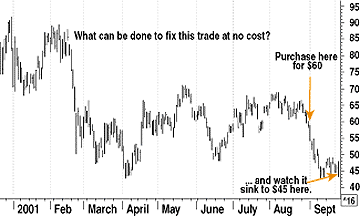OPTIONS
Trading Trouble? Here's Some Help
Repair Strategies With Options
by Kevin Lund and Tom Gentile
Here's a strategy for fixing a good trade gone bad.
As we've seen many times in the last year, a gap down with bad news on a stock you're holding can not only be devastating to your trading account, but may also test the depths of your skills as a trader. Even if you are the most gifted, insightful trader around and you are certain the stock will move in your favor, the financial markets are sure to humble you - as they did everyone the week following the tragedies of September 11. Though it may seem hopeless when major failures occur, there are ways to fix such trades with virtually no additional cost or risk to you. Using options to fix a good stock trade gone bad is not only a smart way to get yourself out of a bind, but it may also be one of the only logical means for repair.
VARIOUS STRATEGIES
In order to fix a position after a collapse, you must first accept that
the loss is real, and that time is of the essence if you wish to implement
a repair strategy. Say for example you purchase a stock at $50 and it drops
to $40 overnight. The methods of fixing a trade like this boil down to
one of three choices (using stock alone):
1. Accept the loss, close the position, and move on. (This is not a very creative method, and assures that no further gains - or losses - will be made on the trade.)
2. Double down on the position by purchasing the same number of shares at the reduced price, thus lowering the breakeven point but adding twice the risk to an already losing position.
3. Hang onto the position, hoping to break even on it someday. (Anyone still holding onto shares of Lucent Technologies, Inc. (LU), or Nortel Networks Corp. (NT), among others, can attest to this form of investing as a lesson in futility at best.)
Realistically, the first option would generally be the wisest if you believe the story is over for the company and there really is no hope of a rebound in the price of the stock. However, you may have reason to believe the selloff is overdone, and none of these choices will be appealing if you understand the multidimensional leveraging attributes that stock options offer. An understanding of how options can be used to effectively hedge any strategy should be a part of your arsenal. So with that in mind, how do you fix a sweet trade that's gone sour?
First, if the stock has lost more than 50% of its value from the time you originally purchased it, all repair strategies will be limited in their effectiveness. So make sure you're still dealing with a viable possibility of a price rebound. Let's see how you could position yourself to benefit from a rebound by lowering your breakeven without incurring additional risk or cost, using Qualcomm, Inc. (QCOM), as a recent example (Figure 1).

Figure 1: QUALCOMM, INC. (QCOM). Even a trade that has been beaten this badly can be saved.
...Continued in the December 2001 issue of Technical Analysis of STOCKS & COMMODITIES
Excerpted from an article originally published in the December 2001 issue of Technical Analysis of STOCKS & COMMODITIES magazine. All rights reserved. © Copyright 2001, Technical Analysis, Inc.